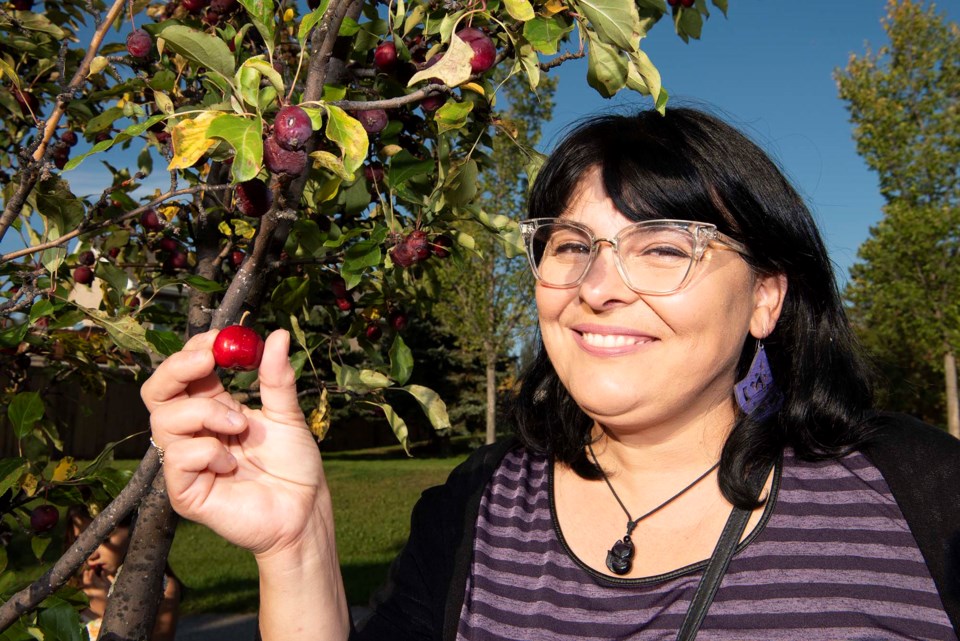Neighbours for climate
The Gazette is using the City of Edmonton’s Neighbouring for Climate guide to help St. Albert streets fight back against climate change. Check out the guide at edmonton.ca/climateneighbours.
When Aida Mustapic wants fresh fruit in St. Albert, she doesn’t have to go to a store. She just goes for a walk, knowing there is free food growing everywhere along the trails in St. Albert.
“There are a lot of edibles around these trees,” she said, as she walked near Sturgeon Heights School last week — currants and crabapples here, and yellow plums, gooseberries, apricots, and saskatoons elsewhere in town.
She plucked an overripe crabapple from one of several trees around Dixon’s Pond in Northridge and took a bite.
“Super sweet!” she declared.
Food takes energy to grow and decays into heat-trapping pollution if left to rot on the ground or the compost heap. Edmonton’s Neighbouring for Climate guide says residents can address climate warming, boost food security, and save money by sharing and harvesting excess food.
Waste not
One way to do this is to exchange food. Mustapic said this happens frequently through the St. Albert Backyard Gardening group on Facebook, which she founded several years ago as a way for people to share food, plants, and knowledge.
“There are frequently posts that say, ‘I have too many apples,’ or ‘I have too many peas,’ or ‘I have too many cherries, would anyone like to come pick some?’” she said.
Mustapic said these posts let people distribute their excess produce instead of having it rot. Many end up donating their crops to the food bank.
Sharing food can be as simple as offering it to your neighbours or making a post online. For more organized efforts, Mustapic said residents can arrange plant or food swaps in local parks. Her group holds regular seed and plant swaps at Red Willow Place, for example, and held a harvest potluck dinner in Lions Park on Sept. 15.
“Gardening for many people has become more than just a hobby,” she noted, and instead now acts as an important source of affordable food.
Mustapic said food rescue groups such as Leftovers and Fruits of Sherbrooke can help you harvest and use produce from your yard if you’re unable or unwilling to pick it yourself.
At least half of the produce harvested by Leftovers volunteers goes to charity, said Leftovers Foundation spokesperson Alex Wong. The volunteers and property owners split the rest. Leftovers volunteers prevented some 500 pounds of food from going to waste last August in the Edmonton region.
Mustapic said sharing food has helped her become friends with people across St. Albert, and helped gardeners share tips on how to raise crops that can stand up to drought and extreme heat (both of which will become more likely in St. Albert due to climate change).
“St. Albert has become a very small community for me!” she said.
Map it out
You can also prevent food waste by collecting wild fruit.
Mustapic said she started doing this with the crabapple trees and currant bushes growing along St. Albert’s trails years ago after noticing their fruits were being left uneaten year after year. Nowadays, she and her neighbours typically head out and harvest wild fruit once a year, teaching their kids about edible plants in the process.
Most of the edible plants on St. Albert’s public land are shrubs or bushes such as saskatoons, which crews sometime plant in natural areas, said City of St. Albert parks operations supervisor Erin Pickard. Many park beds also contain rhubarb. Crews tend not to plant fruit trees as they can attract coyotes or wasps, but there are some around.
Pickard said the produce these plants create is free for the taking.
“If people can make use of those edibles, that’s great.”
Pickard said residents concerned about pesticides on wild produce should call public works to see if an area has been sprayed. (Sprayed areas will have warning signs posted around them.) They should not prune public fruit trees, as that’s illegal under the parks bylaw; get public works to do the pruning instead.
If you don’t know where to find wild produce around St. Albert, you can always check a map. Becky Shepherd started the Free Fruit to Pick in St. Albert map (available at bit.ly/45Zlvac) in 2017 and regularly updates it. The City of Edmonton has a map of nearly 50,000 food-bearing trees and shrubs within its borders (see bit.ly/3LrY5Sl), with some 17,400 people visiting it in the last six months, said City of Edmonton parks and road services general supervisor Nicole Fraser.
Shepherd said picking wild fruits is a fun family activity that can save you money on groceries and reduce pollution caused by food waste and imports. Still, it’s not something you should do unprepared, as not all plants are safe to eat.
“If you’re not 100 per cent sure about what you’re picking, you should not pick it,” Shepherd said.
New foragers should turn to books and experienced foragers to learn how to spot and harvest wild plants, Mustapic said. They can also volunteer at The St. Albert Community Food Forest and the Liberton Food Forest, where expert gardeners can show you which plants are safe to eat.
Mustapic and Shepherd say to follow three rules when harvesting wild fruit: don’t damage the plants, don’t take more than you need, and never strip a tree bare.
“These fruit trees are trees that feed our wild birds over the winter,” Shepherd said, and it’s important to leave food for them.
The fruits you collect can be washed and eaten fresh or used in jams, jellies, and pies, Shepherd said.
“One thing I particularly like to make is called spiced crabapples,” she said. It's a family recipe that involves preserving the apples stem and all with spices and syrup.
“They’re just delicious.”




